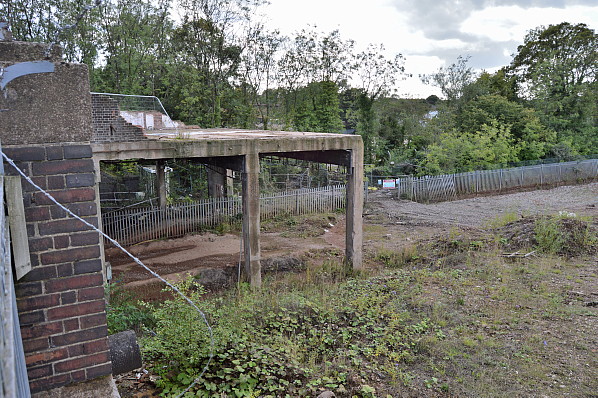
Station Name: LONGBRIDGE 2nd site[Source:
Terry Callaghan]
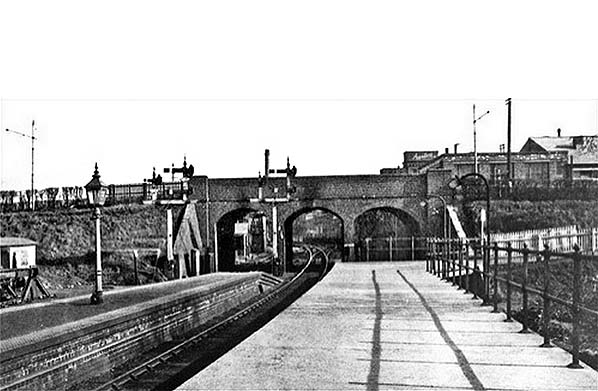
Looking south from the station platform during 1920 at what was the original bridge which carried the A38 Bristol Road over the line. Presumably the station buildings were located to the right.
Photo by S Mourton supplied by Bob Pixton Reproduced with kind permission from the Austin Memories website 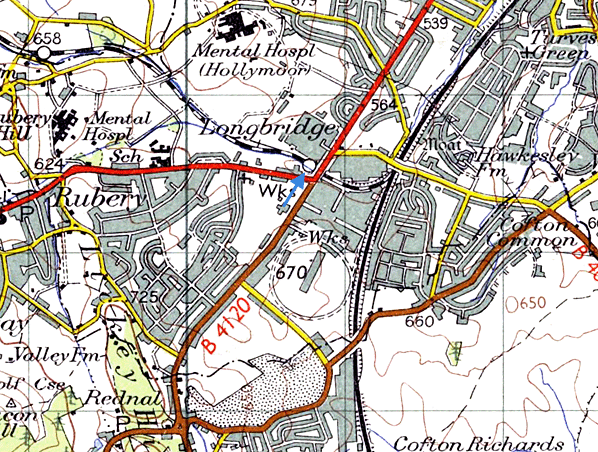 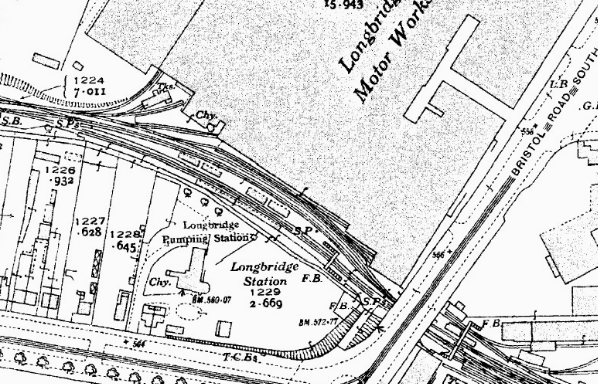 The 1936 1:2500 scale map shows how the Longbridge Motor Works has built up around the station the original plant was situated on the opposite side of the Bristol Road below the existing rail lines. 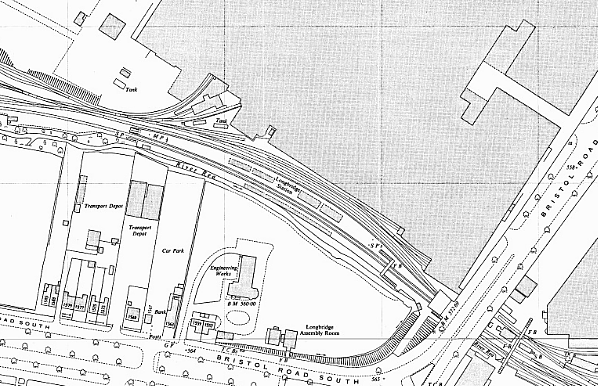 The 1965 os plan at 1:1,2500 scale still shows the station with its booking office on the Bristol Road very little had changed in the area in the intervening period apart from The 1965 os plan at 1:1,2500 scale still shows the station with its booking office on the Bristol Road very little had changed in the area in the intervening period apart fromthe station now being officially closed. 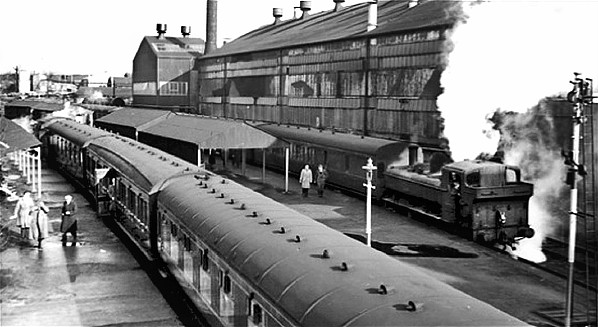 A charming scene from the 1950's with the station busy after the arrival of two workmens trains the train in the foreground is the LMS train from Birmingham New Street composed of an LMS 9 compartment Third Class carriage, designed by William Stanier, followed by a non-corridor compartment coach from the 1920 to 1939 period with a more modern LMS built coach, the fore runner of the BR Mk1. The GWR train is on the opposite platform headed by an 0-6-0 Pannier Tank with some pre-grouping GWR stock wth all the coaches carrying the British Railway's livery. Photographer unknown Reproduced with kind permission from the Austin Memories website old6.jpg) Looking south from the same vantage point as the 1920 picture but this time in 1954. The late 1940's station building can be seen spanning the two lines which pass under the reconstructed A38 overbridge. Photo by D J Norton To see more of the D J Norton collection click here old11.jpg) Looking towards Rubery during June 1954 and the close proximity of the motor works is apparent. The platform that the children are standing on was essentially an access walkway to the part of the works on the opposite side of the Bristol Road although passengers did alight on this side. Photo from the John Mann collection old7.jpg) Looking now from the far north end of the station during March 1962 the Longbridge West box is a MR type 4a design fitted with a 16 lever frame. The box opened on 15 April 1914 and closed on 10 August 1922 it reopened on 21 July 1923 and was finally abolished on 29 October 1961.The platform ramp can be seen along with several sidings and access lines directly into the works. Photo by D J Norton To see more of the D J Norton collection click here old3.jpg) The Last Train on the Harbourne Brach and Farewell to the Halesowen Branch SLS railtour makes a stop at Longbridge on 2 November 1963. Many of the passengers are taking the opportunity to explore the station and photograph the train. LMS Ivatt 2MT class 2-6-0 is at the head of the train for its initial working up the branch. Also of interest is the four plank goods wagon in the foreground with a BR mineral wagon standing a little further on. The Last Train on the Harbourne Brach and Farewell to the Halesowen Branch SLS railtour makes a stop at Longbridge on 2 November 1963. Many of the passengers are taking the opportunity to explore the station and photograph the train. LMS Ivatt 2MT class 2-6-0 is at the head of the train for its initial working up the branch. Also of interest is the four plank goods wagon in the foreground with a BR mineral wagon standing a little further on.Photo by Geoffrey Head old10.jpg) The station site viewed from the Bristol Road in October 1966 the platforms are still very much intact although nature is taking over the platforms. Several mineral wagons are stabled in the works sidings. The station site viewed from the Bristol Road in October 1966 the platforms are still very much intact although nature is taking over the platforms. Several mineral wagons are stabled in the works sidings.Photo from the John Mann collection 1.jpg) By the time this 1977 shot was taken the platforms appear to have been cleared of weeds and resurfaced. The footbridge and the curious sheds on the island platform have also been removed although the ubiquitous mineral wagons still grace the works sidings. Photo by Michael Westley reproduced under Creative Commons Licence from Geograph 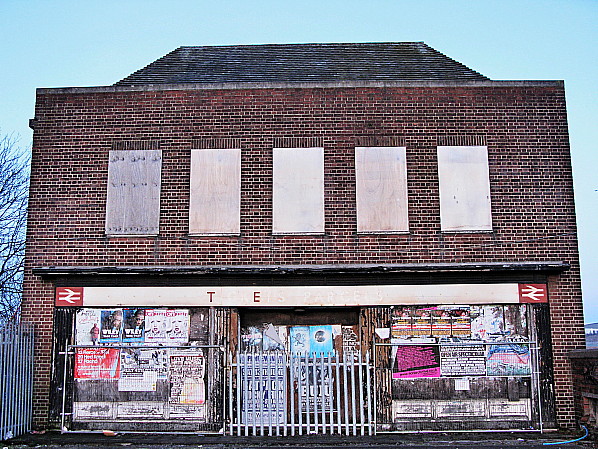 The 1940's ticket office was a feature of the Bristol Road and stood here for over 50 years after closure. Seen here on 28 December 2009 sporting BR Corporate double arrow logos and just two letters from the original 'TICKETS PARCELS' sign. To see more pictures of Longrbidge 2nd site click here
 Home Page Home Page
|
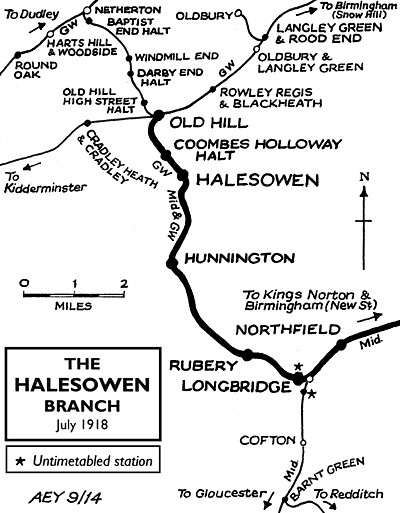 In 1903 the Austin Motor Car Company opened a plant adjacent to the southern end of the Halesowen branch. The company rapidly expanded from employing 1,300 people to over 22,000 by 1918. The First World War played a large part in the rapid expansion as the factory concentrated on producing armaments for the war effort. By 1915 sidings had been laid to connect the factory to the branch and thence to the Bristol to Gloucester main line. Transport links to and from the factory were limited as the original Longbridge station on the main line had closed as far back as 1849. The MR took the initiative and constructed a station a short way up the branch and north of the A38. Sadly, even with extensive research, the design of the buildings remains a mystery. It is known that the station was provided with an island platform and an additional platform on the down side; canopies extended the full length of the platforms. A footbridge from the down platform to the island platform was provided and, latterly, a footbridge from the island platform directly into the works. Access to the station was from the A38 via a ramp onto the down platform.
In 1903 the Austin Motor Car Company opened a plant adjacent to the southern end of the Halesowen branch. The company rapidly expanded from employing 1,300 people to over 22,000 by 1918. The First World War played a large part in the rapid expansion as the factory concentrated on producing armaments for the war effort. By 1915 sidings had been laid to connect the factory to the branch and thence to the Bristol to Gloucester main line. Transport links to and from the factory were limited as the original Longbridge station on the main line had closed as far back as 1849. The MR took the initiative and constructed a station a short way up the branch and north of the A38. Sadly, even with extensive research, the design of the buildings remains a mystery. It is known that the station was provided with an island platform and an additional platform on the down side; canopies extended the full length of the platforms. A footbridge from the down platform to the island platform was provided and, latterly, a footbridge from the island platform directly into the works. Access to the station was from the A38 via a ramp onto the down platform. 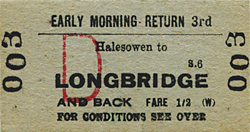 demolished and replaced with a new two-storey brick building which was carried on a concrete raft, supported by stilts and spanning the up and down lines. Its design had a modest dignity, perhaps unexpectedly for an untimetabled station serving a factory. The austere ‘neo-Georgian’ style is reminiscent of schools and public buildings of the 1920s-‘30s; perhaps its designer was familiar with Welwyn Garden City’s centre and station. The steep hipped roof was surrounded by a low parapet, and the tall rectangular windows had 12 lights. The island platform was provided with two ridged canopies, without adornment, backed by screens to prevent access to them from trains calling at the down platform, which had its own slanting canopy. The single-faced down platform was reached by a ramp directly adjacent to the building. A corrugated iron hut where tickets were collected was positioned at the foot of the ramp.
demolished and replaced with a new two-storey brick building which was carried on a concrete raft, supported by stilts and spanning the up and down lines. Its design had a modest dignity, perhaps unexpectedly for an untimetabled station serving a factory. The austere ‘neo-Georgian’ style is reminiscent of schools and public buildings of the 1920s-‘30s; perhaps its designer was familiar with Welwyn Garden City’s centre and station. The steep hipped roof was surrounded by a low parapet, and the tall rectangular windows had 12 lights. The island platform was provided with two ridged canopies, without adornment, backed by screens to prevent access to them from trains calling at the down platform, which had its own slanting canopy. The single-faced down platform was reached by a ramp directly adjacent to the building. A corrugated iron hut where tickets were collected was positioned at the foot of the ramp.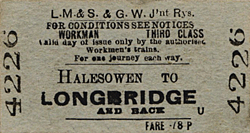 the switch back to the manufacture of cars, passenger numbers decreased, and in April 1919 the MR withdrew the passenger service from Halesowen to Northfield. It was the GWR who recognised that there was still a limited demand by workers travelling to and from the Austin plant, and they introduced two daily morning trains from Old Hill to Longbridge, with two return workings in the evening; these services ran Monday-to-Friday. The MR provided workmen’s trains from Birmingham New Street to Longbridge which also ran Monday-to-Friday. With the outbreak of the Second World War the Austin plant resumed production of armaments and employee numbers once again grew. Both the LMS and the GWR continued to run their respective workmen’s trains to the station, but now seven days a week. Following the end of the war the service again settled down to two trains in each direction from Old Hill and Birmingham New Street run by the GWR and LMS respectively. These services were untimetabled although they ran on a regular basis and it was not unknown for members of the general public to travel on them.
the switch back to the manufacture of cars, passenger numbers decreased, and in April 1919 the MR withdrew the passenger service from Halesowen to Northfield. It was the GWR who recognised that there was still a limited demand by workers travelling to and from the Austin plant, and they introduced two daily morning trains from Old Hill to Longbridge, with two return workings in the evening; these services ran Monday-to-Friday. The MR provided workmen’s trains from Birmingham New Street to Longbridge which also ran Monday-to-Friday. With the outbreak of the Second World War the Austin plant resumed production of armaments and employee numbers once again grew. Both the LMS and the GWR continued to run their respective workmen’s trains to the station, but now seven days a week. Following the end of the war the service again settled down to two trains in each direction from Old Hill and Birmingham New Street run by the GWR and LMS respectively. These services were untimetabled although they ran on a regular basis and it was not unknown for members of the general public to travel on them.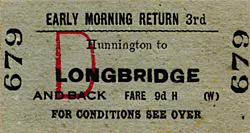 expanded during the 1950s, and with demand for its train services declining BR announced that the workmen’s trains would be discontinued on 29 August 1958. Representations from Birmingham City Council over the issue of the withdrawal had a limited effect, with the Birmingham New Street to Longbridge being retained temporarily. So, on 29 August 1958, the final Longbridge to Old Hill service departed, with the Birmingham New Street services finally ending on 2 January 1960. The council placated inconvenienced passengers with the assurance that
there would be ‘improvements in bus services adequate to cover the
expanded during the 1950s, and with demand for its train services declining BR announced that the workmen’s trains would be discontinued on 29 August 1958. Representations from Birmingham City Council over the issue of the withdrawal had a limited effect, with the Birmingham New Street to Longbridge being retained temporarily. So, on 29 August 1958, the final Longbridge to Old Hill service departed, with the Birmingham New Street services finally ending on 2 January 1960. The council placated inconvenienced passengers with the assurance that
there would be ‘improvements in bus services adequate to cover the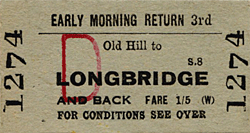 maintained by BR, latterly Railtrack and Network Rail, and this seemed to allow the station building to escape demolition although the platforms had been removed. The ticket/parcels office stood on the A38 until, following the demise of the Rover Group, it was finally demolished in around 2010 as the whole works area was redeveloped. Today just the concrete stilts and the raft that the building stood on remain, along with a short section of the single-faced down platform. The trackbed to the main line is now occupied by a linear park and as the redevelopment crosses to the opposite side of the A38 the station site will soon be swallowed up by it.
maintained by BR, latterly Railtrack and Network Rail, and this seemed to allow the station building to escape demolition although the platforms had been removed. The ticket/parcels office stood on the A38 until, following the demise of the Rover Group, it was finally demolished in around 2010 as the whole works area was redeveloped. Today just the concrete stilts and the raft that the building stood on remain, along with a short section of the single-faced down platform. The trackbed to the main line is now occupied by a linear park and as the redevelopment crosses to the opposite side of the A38 the station site will soon be swallowed up by it.
